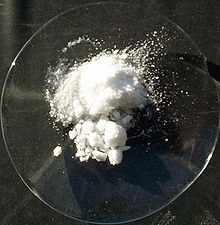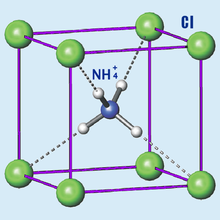Ammonium chloride

| |

| |
| Names | |
|---|---|
| IUPAC name
Ammonium chloride
| |
| Other names
Sal ammoniac
| |
| Identifiers | |
| ECHA InfoCard | 100.031.976 |
| EC Number |
|
| RTECS number |
|
CompTox Dashboard (EPA)
|
|
| Properties | |
| NH4Cl | |
| Molar mass | 53.49 g/mol |
| Appearance | White solid |
| Density | 1.5274 g/cm3 |
| Melting point | 338 °C (decomposes) |
| 29.7 g/100 mL (0 °C) 37.2 g/100 mL (20 °C) 77.3 g/100 mL (100 °C) | |
| Solubility in alcohol | 0.6 g/100 mL (19 °C) |
| Acidity (pKa) | 9.245 |
Refractive index (nD)
|
1.642 |
| Thermochemistry | |
Std molar
entropy (S⦵298) |
94.85 J K−1 mol−1 [1] |
Std enthalpy of
formation ( |
−314.55 kJ/mol[1] |
| Hazards | |
| NFPA 704 (fire diamond) | |
| Flash point | Non-flammable |
| Lethal dose or concentration (LD, LC): | |
LD50 (median dose)
|
1650 mg/kg, oral (rat) |
| Related compounds | |
Other anions
|
Ammonium fluoride Ammonium bromide Ammonium iodide |
Other cations
|
Sodium chloride Potassium chloride Hydroxylamonium chloride |
Except where otherwise noted, data are given for materials in their standard state (at 25 °C [77 °F], 100 kPa).
| |
Ammonium chloride (NH4Cl) (also Sal Ammoniac, salmiac, nushadir salt, sal armagnac, sal armoniac, salt armoniack) is, in its pure form, a clear white water-soluble crystalline salt of ammonia. The aqueous ammonium chloride solution is mildly acidic. Sal ammoniac is a name of natural, mineralogical form of ammonium chloride. The mineral is especially common on burning coal dumps (formed by condensation of coal-derived gases), but also on some volcanoes.
Sources
The substance occurs naturally in volcanic regions, forming on volcanic rocks near fume-releasing vents. The crystals deposit directly from the gaseous state, and tend to be short-lived, as they dissolve easily in water. It is a by-product of the Solvay process used to produce sodium carbonate.[2]
Ammonium chloride is prepared commercially by reacting ammonia (NH3) with hydrogen chloride (HCl). As these chemicals are corrosive, this process has to be performed in vessels lined with nonreactive materials (e.g. glass, enamel, lead, or PVC).[2]
- NH3 + HCl → NH4Cl
This reaction can occur if poorly sealed bottles of household ammonia (ammonium hydroxide) and hydrochloric acid are stored in close proximity, leading to crystals forming around the opening of one of the bottles (whichever is leaking more slowly).[citation needed]
Reactions
Ammonium chloride sublimes readily but this process involves dissociation into ammonia and hydrochloric acid followed by reforming of the compound.[2]
- NH4Cl → NH3 + HCl
Applications
Ammonium chloride is sold in blocks at hardware stores for use in cleaning the tip of a soldering iron and can also be included in solder as flux.
Other uses include a feed supplement for cattle, in hair shampoo, in textile printing, in the glue that bonds plywood, as an ingredient in nutritive media for yeast, in cleaning products, and as cough medicine. Its expectorant action is caused by irritative action on the bronchial mucosa. This causes the production of excess respiratory tract fluid which presumably is easier to cough up. It is also used in an oral acid loading test to diagnose distal renal tubular acidosis.
In several countries sal ammoniac is used to spice up liquorice-type dark candies (Finland's salmiakki, Sweden's lakrisal, the Netherlands' zoute drop and the Danish Dracula Piller are popular examples), and as a flavoring for vodkas.
Ammonium chloride is also used for contact explosives, diuretic and systemic acidifying agent. It is used in the treatment of severe metabolic alkalosis, to maintain the urine at an acid pH in the treatment of some urinary-tract disorders or in forced acid diuresis.
Ammonium salts are an irritant to the gastric mucosa and may induce nausea and vomiting.
Biological applications include using it as an energy source for microbiological growth of organisms.
The zero point of Fahrenheit is determined by placing the thermometer in a mixture of ice, water, and ammonium chloride.
Also used: to luster cotton, as a metal cleaner in soldering, as a flux in tin coating and galvanizing, in fertilizers, in safety explosions and in dying and tanning.
See also
References
- ^ a b Solid state data from Ammonium chloride in Linstrom, Peter J.; Mallard, William G. (eds.); NIST Chemistry WebBook, NIST Standard Reference Database Number 69, National Institute of Standards and Technology, Gaithersburg (MD) (retrieved 2008-10-22)
- ^ a b c Egon Wiberg, Arnold Frederick Holleman (2001) Inorganic Chemistry, Elsevier ISBN 0123526515

